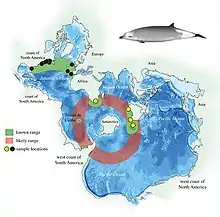| Ramari's beaked whale | |
|---|---|
 | |
| Scientific classification | |
| Domain: | Eukaryota |
| Kingdom: | Animalia |
| Phylum: | Chordata |
| Class: | Mammalia |
| Order: | Artiodactyla |
| Infraorder: | Cetacea |
| Family: | Ziphiidae |
| Genus: | Mesoplodon |
| Species: | M. eueu |
| Binomial name | |
| Mesoplodon eueu Carroll et al, 2021 | |
 | |
| Sampling locations in the NA (black circles; True's beaked whale) and SH (yellow circle; Ramari's beaked whale) | |
Ramari's beaked whale (Mesoplodon eueu) is a medium size whale in the genus Mesoplodon. It is found in cool waters of the Southern Hemisphere. The species name, eueu, comes from the Khwedam word meaning 'big fish', as most of the strandings of these whales come from Khoisan territories in South Africa. The common name honours Māori whale expert Ramari Stewart.[3]
It was previously thought to represent an Indian Ocean population of True's beaked whale (M. mirus), although there was speculation that it could be a distinct subspecies of True's beaked whale. However, studies of the Indian Ocean beaked whales found them to be genetically distinct from True's beaked whale, having diverged in the early Pleistocene, and also found them to have a much wider range throughout the Southern Hemisphere. They were thus described as a distinct species, M. eueu.[3]
The holotype is a 5-metre-long (16 ft) pregnant female who washed ashore in 2011 on Waiatoto Spit, south of Haast, New Zealand. She was named Nihongore by Te Rūnanga o Makaawhio. She was initially thought to be a True's beaked whale but further research has confirmed she is genetically and morphologically distinct from the Northern Hemisphere whales. The complete skeleton of her and her foetus are held in the Museum of New Zealand Te Papa Tongarewa in Wellington, and a tissue sample is in the New Zealand Cetacean Tissue Archive in Auckland. The paratype specimens of five individuals are held in Port Elizabeth Museum and Iziko South African Museum.[3][4]
References
- ↑ Brownell Jr & R.L. & Pitman, R.L. (2022). "Mesoplodon eueu". IUCN Red List of Threatened Species. 2022: e.T215824818A215824841. doi:10.2305/IUCN.UK.2022-2.RLTS.T215824818A215824841.en. Retrieved 9 December 2022.
- ↑ "Appendices | CITES". cites.org. Retrieved 2022-01-14.
- 1 2 3 Carroll, Emma L.; McGowen, Michael R.; McCarthy, Morgan L.; Marx, Felix G.; Aguilar, Natacha; Dalebout, Merel L.; Dreyer, Sascha; Gaggiotti, Oscar E.; Hansen, Sabine S.; van Helden, Anton; Onoufriou, Aubrie B.; Baird, Robin W.; Baker, C. Scott; Berrow, Simon; Cholewiak, Danielle; Claridge, Diane; Constantine, Rochelle; Davison, Nicholas J.; Eira, Catarina; Fordyce, R. Ewan; Gatesy, John; Hofmeyr, G. J. Greg; Martín, Vidal; Mead, James G.; Mignucci-Giannoni, Antonio A.; Morin, Phillip A.; Reyes, Cristel; Rogan, Emer; Rosso, Massimiliano; Silva, Mónica A.; Springer, Mark S.; Steel, Debbie; Olsen, Morten Tange (27 October 2021). "Speciation in the deep: genomics and morphology reveal a new species of beaked whale Mesoplodon eueu". Proceedings of the Royal Society B: Biological Sciences. 288 (1961): 20211213. doi:10.1098/rspb.2021.1213. PMC 8548795. PMID 34702078. S2CID 239890028.
- ↑ Wilson, Rebecca (13 March 2012). "Rare beaked whale seen in New Zealand for the first time | Conservation blog". blog.doc.govt.nz. Retrieved 27 October 2021.
